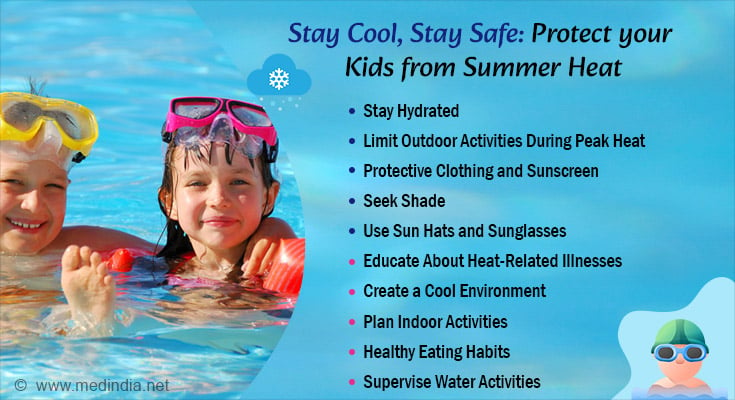- Hydration, shade, and sun protection are key to preventing heat-related illnesses in children
- Educating kids about heat dangers empowers them to recognize and respond to symptoms
- Planning indoor activities and monitoring water play are essential for summer safety
As the temperatures rise and school bells ring their final chimes, children everywhere eagerly anticipate the freedom and adventure of summer vacation. But along with the excitement of endless days of play and exploration comes the responsibility of parents to ensure their children’s safety and well-being, especially during the scorching heat of summer (1✔ ✔Trusted Source
Issues in summer safety: a call for sun protection
).
With heatwaves becoming more common, it’s crucial to be prepared and proactive in safeguarding kids against the risks associated with high temperatures.
Children’s bodies heat up 3 to 5 times faster than adults. #summer #beattheheat #medindia’
Top 10 Ways for Kids to be Safe and Healthy During Summer
Here are some essential tips for parents to protect their children and promote their health during the summer months.
1. Stay Hydrated:
Dehydration is a significant concern during hot weather, especially for active children. Encourage your kids to drink plenty of water throughout the day, even if they don’t feel thirsty. Pack reusable water bottles for outings and remind them to take regular water breaks during outdoor activities.
2. Limit Outdoor Activities During Peak Heat:
Schedule outdoor playtime during the cooler hours of the day, typically in the early morning or late afternoon. Avoid outdoor activities during the peak heat of the day, usually between 10 a.m. and 4 p.m. If outdoor play is unavoidable, seek shaded areas and take frequent breaks indoors to cool down.
3. Protective Clothing and Sunscreen:
Dress your children in lightweight, loose-fitting clothing that covers their skin and provides adequate sun protection. Apply sunscreen with a high SPF (Sun Protection Factor) to exposed skin, including the face, neck, arms, and legs. Reapply sunscreen every two hours, or more frequently if they’ve been swimming or sweating.
4. Seek Shade:
When spending time outdoors, find shaded areas such as under trees, umbrellas, or canopies to help reduce exposure to direct sunlight. Encourage children to take breaks in the shade to cool down and rest.
Advertisement
5. Use Sun Hats and Sunglasses:
Equip your children with wide-brimmed hats that shade their face, ears, and neck from the sun’s rays. Sunglasses with UV protection are also essential to safeguard their eyes from harmful ultraviolet radiation.
6. Educate About Heat-Related Illnesses:
Teach your children about the signs and symptoms of heat-related illnesses, such as heat exhaustion and heatstroke. Symptoms may include excessive sweating, dizziness, nausea, rapid heartbeat, and confusion. Encourage them to speak up if they experience any of these symptoms and know when to seek help.
Advertisement
7. Create a Cool Environment:
Ensure your home provides a cool and comfortable retreat from the heat. Use fans, air conditioning, or open windows to circulate air and maintain a comfortable indoor temperature. Consider installing window shades or curtains to block out direct sunlight.
8. Plan Indoor Activities:
On particularly hot days, plan indoor activities to keep children entertained and engaged while avoiding the heat outdoors. Indoor games, arts and crafts, movie marathons, or visits to air-conditioned public spaces like libraries or malls are excellent alternatives.
9. Healthy Eating Habits:
Encourage a balanced diet rich in fruits, vegetables, and hydrating foods like watermelon, cucumber, and strawberries. Avoid heavy, greasy meals that can make children feel sluggish and exacerbate dehydration.
10. Supervise Water Activities:
If your children are swimming or playing in water, always supervise them closely, even if they are strong swimmers. Drowning can occur quickly and silently, so maintain constant vigilance around pools, lakes, or any body of water.
Bonus Tip:
Stay Informed:
Keep abreast of weather forecasts and heat advisories in your area. Stay informed about any heat-related warnings or alerts issued by local authorities and adjust your plans accordingly.
By implementing these strategies, parents can help ensure their children stay safe, healthy, and happy throughout the summer vacation. While the allure of
Reference:
- Issues in summer safety: a call for sun protection – (https://pubmed.ncbi.nlm.nih.gov/12024352/)
Source-Medindia








